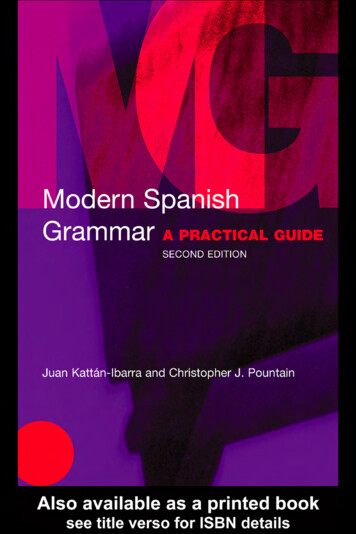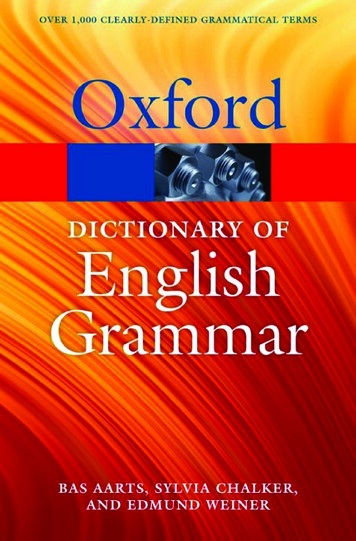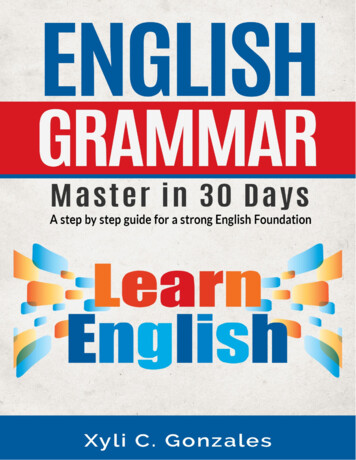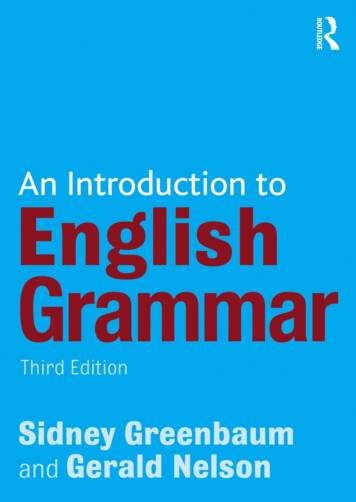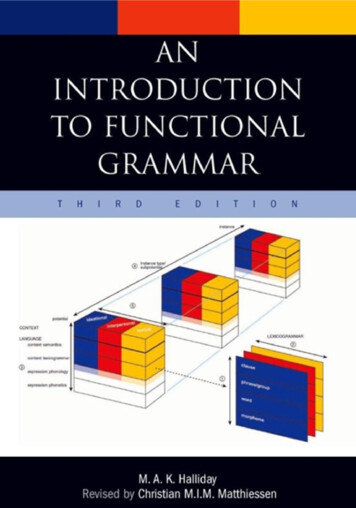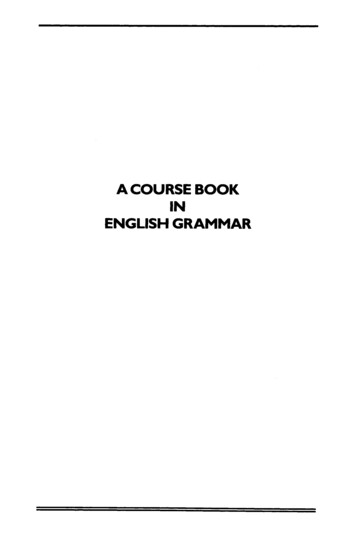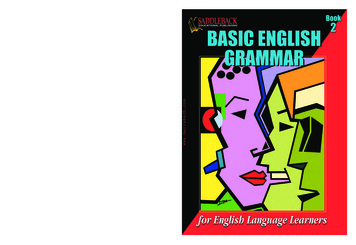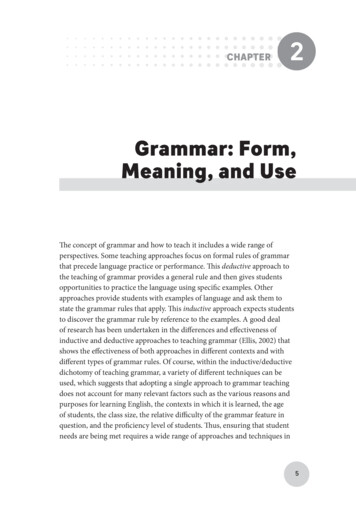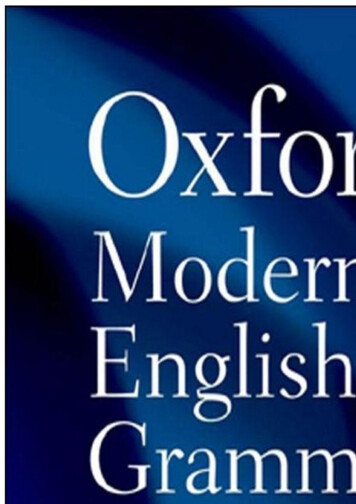
Transcription
Oxford Modern English Grammar
Bas Aarts is Professor of English Linguistics and Director of the Survey of EnglishUsage at University College London. His previous books include Small Clauses inEnglish: The Nonverbal Types (Mouton de Gruyter, 1992); The Verb inContemporary English , co-edited with Charles F. Meyer (Cambridge UniversityPress, 1995); English Syntax and Argumentation (Palgrave, 1997, 2001, 2008);Investigating Natural Language: Working with the British Component of theInternational Corpus of English , co-authored with Gerald Nelson and Sean Wallis(John Benjamins, 2002); Fuzzy Grammar: A Reader , co-edited with David Denison,Evelien Keizer, and Gergana Popova (Oxford University Press, 2004); The Handbookof English Linguistics , co-edited with April McMahon (Blackwell, 2006); andSyntactic Gradience: The Nature of Grammatical Indeterminacy (Oxford UniversityPress, 2007). He is one of the founding editors of the journal English Language andLinguistics .
Oxford Modern English GrammarBas AartsDepartment of English Language and Literature University College London
Great Clarendon Street, Oxford OX 2 6DPOxford University Press is a department of the University of Oxford.It furthers the University’s objective of excellence in research, scholarship,and education by publishing worldwide inOxford New YorkAuckland Cape Town Dar es Salaam Hong Kong KarachiKuala Lumpur Madrid Melbourne Mexico City NairobiNew Delhi Shanghai Taipei TorontoWith offices inArgentina Austria Brazil Chile Czech Republic France GreeceGuatemala Hungary Italy Japan Poland Portugal SingaporeSouth Korea Switzerland Thailand Turkey Ukraine VietnamOxford is a registered trade mark of Oxford University Pressin the UK and in certain other countriesPublished in the United Statesby Oxford University Press Inc., New York Oxford University Press 2011The moral rights of the author have been assertedDatabase right Oxford University Press (maker)First published 2011All rights reserved. No part of this publication may be reproduced,stored in a retrieval system, or transmitted, in any form or by any means,without the prior permission in writing of Oxford University Press,or as expressly permitted by law, or under terms agreed with the appropriatereprographics rights organization. Enquiries concerning reproductionoutside the scope of the above should be sent to the Rights Department,Oxford University Press, at the address aboveYou must not circulate this book in any other binding or coverand you must impose the same condition on any acquirerBritish Library Cataloguing in Publication DataData availableLibrary of Congress Cataloging-in-Publication Data
Data availableTypeset by Glyph International, Bangalore, IndiaPrinted in Great Britainon acid-free paper byClays Ltd., St Ives plcISBN 978–0–19–953319–01 3 5 7 9 10 8 6 4 2
In memory of my mother Sjé Aarts-Postmes (1934–2008)
ContentsList of figuresList of tablesPrefaceNotational conventions and abbreviationsAbbreviationsPart I: The basicsChapter 1: An overview of English grammarPart II: Form and functionChapter 2: Word structure and word-formationChapter 3: Word classes and simple phrasesChapter 4: Grammatical functions, semantic roles, and tree diagramsPart III: Phrase and clause patternsChapter 5: Complex phrases and coordinationChapter 6: Clause types and negationChapter 7: Finite subordinate clausesChapter 8: Non-finite and verbless subordinate clausesPart IV: Grammar and meaningChapter 9: Tense and aspectChapter 10: MoodChapter 11: Information structuringAppendix 1: English irregular verbsAppendix 2: The structure of the ICE-GB corpusNotes and further reading
List of sources of examplesReferencesSubject IndexLexical Index
List of figuresFigure 2.1: The field of morphologyFigure 3.1: The subclassification of English verbs
List of tablesTable2.1:The person systemTable2.2:The paradigm for the regular verb INSULTTable2.3:The paradigm for the irregular verb BREAKTable2.4:The progressive, perfect, and passive constructionsTable2.5:The present tense forms of the verb BETable2.6:Non-finite clausesTable2.7:Plural-formationTable2.8:The case forms of personal pronounsTable2.9:The inflectional forms of adjectives and adverbsTable2.10:Some common derivational suffixesTable2.11:Some common derivational prefixes
Table2.12:Compound nounsTable2.13:Compound verbsTable2.14:Compound adjectivesTable2.15:Compound prepositionsTable2.16:Compound adverbsTable2.17:Combining formsTable3.1:Word classesTable3.2:Some common nominal suffixesTable3.3:The distributional properties of typical nounsTable3.4:Pronoun subclassesTable3.5:Reflexive pronounsTable3.6:Reciprocal pronouns
Table3.7:Relative pronounsTable3.8:Interrogative pronounsTable3.9:Demonstrative pronounsTable3.10:Indefinite pronounsTable3.11:DeterminativesTable3.12:The distributional properties of typical determinativesTable3.13:The distributional properties of typical adjectivesTable3.14:The modal auxiliariesTable3.15:The perfect constructionTable3.16:The progressive constructionTable3.17:The passive constructionTable3.18:Uses of dummy DO
Table3.19:PrepositionsTable3.20:Complex bal prepositionsTable3.23:Subordinating conjunctionsTable4.1:Grammatical functionsTable4.2:The properties of typical SubjectsTable4.3:The properties of typical Direct ObjectsTable4.4:A selection of transitive verbsTable4.5:The properties of typical Indirect ObjectsTable4.6:A selection of ditransitive verbsTable
4.7:A selection of linking verbsTable4.8:A selection of complex transitive verbsTable4.9:The distributional properties of typical Predicative ComplementsTable4.10:The distributional properties of PPCsTable4.11:A selection of verbs licensing PPCsTable4.12:The distributional properties of typical AdjunctsTable4.13:Semantic rolesTable5.1:Grammatical functions at phrase levelTable5.2:Determiners in noun phrasesTable5.3:Predeterminers in noun phrasesTable5.4:Complements in noun phrasesTable5.5:Adjuncts in noun phrases
Table5.6:Complements in adjective phrasesTable5.7:Adjuncts in adjective phrasesTable5.8:Complements in verb phrasesTable5.9:Basic complementation patternsTable5.10:An overview of constructions involving non-locative PPs functioningas PPCTable5.11:An overview of constructions involving locative PPs functioning asPPCTable5.12:Adjuncts in verb phrasesTable5.13:Complements in prepositional phrasesTable5.14:Conjunctive prepositionsTable5.15:Conjunctive complex prepositionsTable5.16:Adjuncts in prepositional phrasesTable5.17:Complements in adverb phrases
Table5.18:Adjuncts in adverb phrasesTable6.1:The properties of declarative clausesTable6.2:The properties of open interrogative clausesTable6.3:The properties of closed interrogative clausesTable6.4:The properties of imperative clausesTable6.5:The properties of exclamative clausesTable6.6:Overview of the clause types: syntax and useTable7.1:Finite subordinate clausesTable7.2:Content clausesTable7.3:Verbs occurring in the pattern ‘DECIDE [ clause that ]’Table7.4:Verbs occurring in the pattern ‘WONDER [ clause if/whether/wh- phrase ]’TableVerbs occurring in the pattern ‘MENTION ([ PP to NP]) [ clause that ]’
7.5:Table7.6:Verbs occurring in the pattern ‘TELL NP [ clause that ]’Table7.7:Verbs occurring in the pattern ‘ASK NP [ clause whether/if/wh- phrase ]’Table7.8:Verbs occurring in the pattern ‘PERSUADE NP [ clause that ]’Table7.9:Verbs occurring in the pattern ‘REMIND NP [ clause whether/if/ wh phrase ]’Table7.10:Verbs occurring in the pattern ‘It SEEM (PP) [ clause (that/as if) ]’Table7.11:The scalar/non-scalar and equality/inequality contrastsTable8.1:Non-finite clausesTable8.2:Verbs occurring in the pattern ‘WANT [ clause (for ) NP to-infinitive ]’Table8.3:Verbs occurring in the pattern ‘HESITATE [ clause , Ø to- [ clauseinfinitive ]’Table8.4:Verbs occurring in the pattern ‘WONDER [ clause whether/wh- phrase Ø to infinitive ]’Table8.5:Verbs occurring in the pattern ‘TELL NPi [ clause Øi to- infinitive ]’
Table8.6:Verbs occurring in the pattern ‘TELL NPi [ clause wh -phrase Øi to infinitive ]’Table8.7:Verbs occurring in the pattern ‘PERSUADE NPi [ clause Øi to- infinitive ]’Table8.8:Verbs occurring in the pattern ‘ADVISE NPi [ clause whether/wh-phrase Øito-infinitive ]’Table8.9:Table8.10:Table8.11:Verbs occurring in the pattern ‘HAVE [ clause NP bare infinitive ]’Table8.12:Verbs occurring in the patterninfinitive ]’Table8.13:Verbs occurring in the pattern ‘REMEMBER [ clause Ø-ing participle ]’Table8.14:Verbs occurring in the pattern ‘RECOMMEND [ clause NP/NP’s -ingparticiple ]’Table8.15:Verbs occurring in the pattern ‘PREVENTparticiple ]]’Table8.16:Verbs occurring in the pattern ‘REGARDparticiple ]]’bare-ing-ing
Table8.17:Verbs occurring in the pattern ‘FIND NPi [ clause Øi -ing participle ]’Table8.18:Verbs occurring in the pattern ‘DESCRIBE NPi [ PP as [ clause Øi -ingparticiple ]]’Table8.19:Table8.20:Verbs occurring in the pattern ‘HAVE [ clause NP past participle ]’Table10.1:Frequencies of the English core modal auxiliaries per million words inthe ICE-GB corpusTable10.2:The morphosyntactic properties of the modal verbsTable10.3:The uses of WILL /wouldTable10.4:The uses of SHALLTable10.5:The uses of shouldTable10.6:The uses of CAN / couldTable10.7:The uses of MAY /mightTable10.8:The uses of MUST
PrefaceThe aim of this grammar is to offer a modern, concise, but nevertheless wide-rangingdescription of the structure of contemporary standard British and American English.The book is intended for anyone who is interested in English grammar, and has beenwritten without an assumption on my part that the reader has any previous knowledgeof grammatical concepts.The account of grammar presented in this book is descriptive, not prescriptive: itdescribes the language as it is used today. Readers hoping to find confirmation thatthe so-called split infinitive is an odious manifestation of the decline of the Englishlanguage—to give but one example of a common usage shibboleth—will bedisappointed. The view taken here is that the English language is not a static entity,but is continually subject to inevitable change, which is reflected in its lexis andgrammar.It is not possible to write a book like this without acknowledging previous work onEnglish grammar. The framework adopted here relies heavily on the two mostcomplete and in-depth accounts of English grammar currently available, namelyRandolph Quirk, Sidney Greenbaum, Geoffrey Leech, and Jan Svartvik’sComprehensive Grammar of the English Language (1985) and Rodney Huddlestonand Geoffrey Pullum et al.’s Cambridge Grammar of the English Language (2002).These grammars offer sophisticated and detailed descriptions of English that go farbeyond the scope of the present book. It should be noted, however, that I have not inall cases followed the grammatical analyses presented in these books. The majorpoints of divergence are discussed in the Notes and further reading section.I owe an enormous debt of gratitude to Flor Aarts, Peter Collins, Rodney Huddleston,and Geoffrey Leech (in alphabetical order) for reading the entire manuscript andcommenting on it in great detail. I am very fortunate to have received thistremendously valuable feedback from such eminent grammarians, and their input hasmade this a much better book than it would otherwise have been. I’m also grateful tomy editors at Oxford University Press, Ben Harris, Vicky Donald, Rebecca Lane andClare Jenkins. For their help during the editing stage I would like to thank Jill Bowiefor her superb copy-editing, Helen Liebeck for proofreading, and Phil Aslett forcompiling the subject index.BAS AARTSUniversity College LondonApril 2010
Notational conventions and abbreviationsNotational conventions*An asterisk indicates an impossible structure, i.e. a structure thatdoes not conform to the grammatical rules of English. Example:*They likes to read . In this example the third person plural Subjectthey is followed by a verb with a third person singular inflectionalending.ØThis symbol is used to indicate an implicit Subject. Example: I want[Ø to read it].Ørel.This is used to indicate an implicit relativized element. Example:The power [that Ørel enables this union] Coleridge categorized asthe imagination .ØsubThis is used to indicate a missing subordinating conjunction that .Example: They think [Øsub they are funny ]. This symbol is used where the form label can be of different kinds(that is, where the function can be realized by different kinds offorms).These indicate movement, e.g. passivization, extraposition, orarrowsbrackets[ ]raising. Example:is explained below.to enjoy cricket . The underscore symbolBrackets are used:(1) to indicate words that together form a constituent phrase, clause,etc. A labelled bracketing includes a subscript indicator of thesyntactic status of the constituent. Example: [ NP Cats ] [VP eat [ NPfish ]]; (2) to indicate that a lexical item, usually a verb, is followedby a Complement which contains a particular word. Example: HAVE[to ] indicates that the verb HAVE is followed by a Complement thatcontains the word to , e.g. I have to leave .
capitalsThese are used:(1) to indicate functional grammatical labels, e.g. Subject, DirectObject;(2) semantic roles, e.g. Agent, Patient.coindexingItems that are coreferential can be coindexed, i.e. bear the samesubscript letter, usually an ‘i’. Example: He i shaves himselfi twiceevery day .italicsThese are used:(1) to indicate the first time a particular technical term is used;(2) to cite words, sentences, etc. as linguistic forms;(3) to indicate words, phrases, etc. that require highlighting. Forunderlined italics, see below.SMALLCAPSThese indicate lexemes (i.e. dictionary words). Example: the formslaugh, laughs, laughed , and laughing are inflectional formsbelonging to the lexeme LAUGH . The small caps notation will beused for verbs throughout, and for other word classes wheneverrelevant.underlineditalicsWithin italicized technical terms, underlining is used to distinguishcitations of particular words (or other elements), e.g. existentialthere , – ing participle clauses .underscore(‘ ’)This symbol indicates a ‘gap’ in the clause with which a displacedelement is associated. Examples: in What did you see ? the wh word (see below) functions as the Direct Object of the verb SEE andhas been fronted to form an interrogative structure; in the passiveclause The flight was booked by me the gap indicates the positionfrom which the Direct Object of the verb BOOK was moved.wh -wordsThis term is used for a set of words most of which begin with theletters wh -, e.g. what, who , but which also includes how .
AbbreviationsAAdjunctAdj/AdjPadjective/adjective phraseAdv/AdvPadverb/adverb phraseCCComplement e phraseDETDeterminerDODirect ObjectEXT-AExternal AdjunctHHeadICE-GBThe British component of the International Corpus of EnglishindindicativeIOIndirect ObjectMCmatrix clauseN/NPnoun/noun phrase
NICEAn acronym for N egation, I nversion, C ode, E mphasis propertiesP/PPpreposition/prepositional phrasePPi/PPtprepositional phrase headed by an intransitive/transitive prepositionPCPredicative ComplementPCRPredicatorPPCPrepositional Phrase as tiveV -ing-ing participle form of a verbV -ed/-enpast participle form of a verb
V/VPverb/verb phrase
Part I: The basics
Chapter 1An overview of English grammar1.1 Grammar and grammar writingGrammar is concerned with the structure of words (morphology ), and of phrases andclauses (syntax ). There is a long tradition of grammar writing, starting with theancient Greeks and leading up to the present day. This tradition has had a lastinginfluence on how languages—not just English—have been described. The book infront of you is no exception: it will describe the structure of English relying heavilyon this tradition in many different ways, not least in terms of the terminologyadopted. However, it is important to stress that it does not exclusively base itself onthe classical tradition, because it has long been accepted that we should not assumethat the grammar of the classical languages, especially Latin, should serve as a modelfor the description of English. Many grammars of English were written in Latin up tothe middle of the eighteenth century, though William Bullokar’s Pamphlet forGrammar (1586), the first grammar of English to be written in English, is anexception. After 1750 grammarians increasingly recognized that the differencesbetween Latin and English are too great to be ignored. As an example of themismatch between English and Latin grammar, consider the word the , the mostfrequent word in the English language. In English this word belongs to the class ofdeterminatives (see section 1.3 ), but in Latin this word class did not exist, and so ithad to be introduced into grammatical descriptions of English. It is generallyacknowledged that the playwright Ben Jonson was the first person to do so (thoughhe used the more familiar label article ).In the history of grammar writing a number of different types of grammar can bedistinguished. School grammars aim to teach basic and often simplified grammaticalpatterns. Very often they have a prescriptive outlook, rather than a purely descriptiveone—that is, they tell their readers what to do and what not to do when speaking orwriting in English. They were used very widely in the eighteenth and nineteenthcenturies. One of the best known examples was Lindley Murray’s wonderfullyentitled English Grammar, Adapted to the Different Classes of Learners. With anAppendix, Containing Rules and Observations for Promoting Perspicuity in Speakingand Writing (1795). Stemming from this tradition, but more up to date and modern,are pedagogical grammars , used in a variety of educational settings. Traditionalgrammars are detailed scholarly works which belong to the nineteenth and earlytwentieth centuries. They are characterized by their length, usually several weightyvolumes, and their extensive use of literary examples. Principal among them is OttoJespersen’s A Modern English Grammar on Historical Principles (1909–1949). Theaim of theoretical grammar is to discover the (abstract) rules and principlesunderlying the structure (and sometimes use) of language. There are many differenttypes of theoretical approaches to grammar. The best known is probably the theory of
the American linguist Noam Chomsky which aims to arrive at a blueprint for amentally encoded Universal Grammar that all human beings are genetically endowedwith.Although the present book has been influenced by ideas in theoretical work, itsoutlook is the same as that found in modern descriptive reference grammars . Suchgrammars describe the language as it is used today by its speakers, and do not aim tolegislate in matters of ‘correct grammar’. Thus, while you may find a description ofthe so-called split infinitive ( to cheerfully sing in the bath ) in a reference grammar,you will not be told to avoid this construction on the grounds that it is ‘bad English’.Naturally, this does not mean that everything uttered by a speaker of English will beregarded as acceptable. If someone describes a painting as ‘executed brilliant withalso vividly colours’, then they are violating the grammatical rule system of English.You may be wondering at this point whether the use of the split infinitive—or indeedmy use of the pronoun they in the preceding sentence—does not also violate the rulesof English. The answer is ‘no’, and the reason is that the use of the split infinitive andthe use of the plural pronoun they with a non-specific singular antecedent aresanctioned by widespread current usage, the former more so than the latter. Thethinking underlying these observations is that the grammar of a language is shapedover time by the speakers of that language, not by self-appointed individuals orlearned bodies. The efforts of those who have tried in the past to influence how thelanguage should be used have generally failed. Jonathan Swift, who proposed settingup an Academy in his 1712 pamphlet entitled ‘A Proposal for Correcting, Improvingand Ascertaining the English Tongue’, was unsuccessful, and even the lexicographerSamuel Johnson, who thought he could improve the English language when he beganhis magisterial Dictionary of the English Language (published in 1755), had to giveup on that idea. Joseph Priestley was opposed to setting up an Academy, and hisattitude to usage, expressed in his Rudiments of English Grammar (1761),foreshadowed modern thinking when he wrote that the only standard we need toadmit is that of custom.Allowing the language to run its own course means that a previously frowned-uponusage can become normal. For different speakers this will happen at a different pace.Thus, while the interrogative tag innit , as in He left the country, innit? , used inLondon and southeast Britain, is not part of standard English at present, over time itmay well become acceptable in the same way that n’est-ce pas in French isacceptable as a generalized tag. (See section 4.1.1.8 for an explanation of the terminterrogative tag.) A less contentious example of usage that is slowly making its wayinto English is a particular way that the so-called progressive construction is used.This construction involves the verb BE followed by another verb that ends in -ing , asin I’m watching television . In the present tense its typical use is to express that asituation began in the past and is continuing beyond the present moment. Recently ithas been possible to hear people say, for example, I’m wanting to learn aboutgrammar , where the more established pattern is I want to learn about grammar .This novel use of the progressive construction is also found in the slogan I’m lovingit! , coined by a popular purveyor of fast food. While usage matters will play a role in
this grammar, they will not be the main focus of attention.Instead of following the classical tradition too closely I will be describing thegrammar of standard English as a system in its own right, making use of the insightsof modern linguistics. As noted in the Preface, the descriptive framework adoptedhere is influenced by two major grammars of English, namely Quirk et al .’sComprehensive Grammar of the English Language (1985) and Huddleston andPullum et al .’s Cambridge Grammar of the English Language (2002). Thedescription will focus on the two main standard varieties of English: British Englishand American English. Throughout, I will use authentic (occasionally adapted)written and spoken language data taken from two kinds of sources to illustrategrammatical points. The primary source is the British component of the InternationalCorpus of English (ICE-GB), based at the Survey of English Usage, UniversityCollege London. This is a collection of 500 ‘texts’ (passages of 2,000 words) ofgrammatically analysed spoken and written English selected from various types ofcategories of language use. The structure of the ICE-GB corpus is outlined inAppendix 2. The second kind of source of examples includes online broadsheetnewspapers, news channels such as BBC News, and the like. The sources of theexamples are listed at the back of the book. As we saw above, traditional grammarsoften used literary examples, while more modern texts on grammar often use madeup examples. Using authentic examples is preferable because they offer an insightinto how language is used naturally in real situations.The grammar of English is a complex system in which all the components interact. Inorder to help readers get a grip on this system the remainder of this chapter willconsist of an overview of the basic components of grammar. The section numberscorrespond to the chapter numbers. Parts II, III, and IV of the book will then offer adetailed elaboration of this system. It is important to mention from the outset that thegrammar of English is by no means fixed and agreed upon, and no description of itcan in any way be regarded as definitive. To guide readers in understanding thedifferences in the treatment of particular grammatical phenomena in otherframeworks, I will include brief discussions of other treatments in the Notes andfurther reading section at the end of the book.1.2 Word structure and word-formationWe start with a discussion of words. Consider (1 ) below:1 The very noisy visitor continually insulted the receptionist and the caretaker in thelibrary.Trivially, this structure contains fourteen orthographic words , that is, words as theyappear in writing separated by blank spaces. In speech all the words are strungtogether without pauses, and someone who does not know English will not knowwhere the word boundaries are. As for the meanings of the words in (1 ), if you didnot know a particular word, you would consult a dictionary. In all cases, except for
insulted , you would look for the word in the dictionary under the form in which itappears in (1 ). Thus, in the case of noisy you would look under NOISY ; in the case ofreceptionist you would look under RECEPTIONIST ; but in the case of insulted youwould look under INSULT . Words which can act as dictionary entries are calledlexemes (indicated above in SMALL CAPS ), whereas words which perform a particulargrammatical role (e.g. ‘present tense form’) are called inflectional forms (orgrammatical words ). The inflectional forms associated with the lexeme INSULT are:insult , insults , insulted , and insulting . Notice that insulted in (1 ) is an orthographicword as well as an inflectional form (namely the past tense form of the verb INSULT ),but not a lexeme. Many words, but not all, have an internal structure. For example,the word insulted ends in -ed which is called a past tense inflection . This word thuscommunicates at least two things: the meaning ‘offend verbally’, and ‘pastness’. Theinternal structure of words will be discussed in Chapter 2 , as well as word-formationprocesses such as derivation, compounding, and conversion.1.3 Word classes and simple phrasesTraditionally words are categorized into parts of speech which are also called wordclasses . English has the following word classes: noun , determinative , adjective ,verb , preposition , adverb , conjunction , and interjection . The word class labels arereferred to as form labels .You will have come across the notion of a noun as a naming word, that is, a word thatnames a person, place, or thing. In (1 ) the words visitor , receptionist , caretaker ,and library are nouns. In front of visitor we have three items. First we have the wordthe which is an example of a determinative , though you may be more familiar withthe term definite article (the indefinite article is a ). We also have noisy which is adescriptive word that tells you more about the person that the noun visitor refers to.We call such words adjectives . The adjective noisy is itself modified by very whichbelongs to the word class of adverbs . Next, we have continually . This is also anadverb, but this time it modifies the inflectional form insulted , which we called averb. We will see in Chapter 3 that adverbs can modify items from more than onetype of word class. Linking the phrases the receptionist and the caretaker we have theword and , which is a conjunction , more specifically a coordinating conjunction . Wewill need to distinguish such conjunctions from subordinating conjunctions . Thelatter are words like that , whether , and if which can introduce a subordinate clause ,as in (2 ).2 I think [ clause that he sings with a choir ].A clause is a grammatical structure that exemplifies a Subject–Predicate relationship, that is, a structure where ‘something is said about’ (‘predicated of’) a Subject.Simple sentences like (1 ) contain only one clause, whereas (2 ) contains two clauses,namely the structure as a whole, and the string that he sings with a choir . Finally, wewill say that in (1 ) the word in , which here carries a spatial meaning, is a preposition. We refer to the sequence enclosed in square brackets in (2 ) as a labelled bracketing
. The brackets indicate that the string of words is a constituent (section 1.4 ) whosegrammatical status is indicated by the subscript label.Words are grouped together into phrases . Examples of noun phrases (NPs) in (1 )are the very noisy visitor , the receptionist , the caretaker , and the library . The stringvery noisy is an adjective phrase (AdjP). As we have seen, the words very andcontinually are adverbs, but they are also adverb phrases (AdvPs). In Chapter 3 wewill see that a word on its own can also be a phrase. The sequence in the library in (1) is a prepositional phrase (PP). A final type of phrase is the verb phrase (VP). InChapter 3 we will see that the verb phrase in (1 ) does not consist only of the verbinsulted , but also includes the phrases continually , the receptionist and the caretaker, and in the library . Every phrase has an element that functions as its Head . This isthe most prominent element which the phrase as a whole is a ‘kind of’. Thus in thephrase the noisy visitor the element visitor is the Head, and this is because a noisyvisitor is a kind of visitor. Noun phrases are headed by nouns, adjective phrases areheaded by adjectives, verb phrases are headed by verbs, and so on.1.4 Grammatical functions, semantic roles, and tree diagramsConsider (3 ) below.3 The receptionist and the caretaker continually insulted the very noisy visitor in thelibrary.Here we have the same words as in (1 ), but in a different order. This results in aradically different meaning. How can we account for this? In order to explain why wecan have the same words and yet a different meaning in (1 ) and (3 ), we need toappeal to a few further gra
Oxford Modern English Grammar Bas Aarts Department of English Language and Literature University College London. Great Clarendon Street, Oxford OX 2 6DP Oxford University Press is a department of the University of Oxford. It furthers the University's objective of excellence in research, scholarship,

